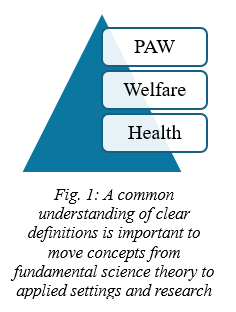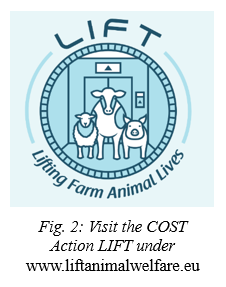POSITIVE ANIMAL WELFARE IN FARMED FISH
Positive animal welfare as a concept
Positive animal welfare (PAW) is an evolving concept, shifting from minimising suffering to promoting positive experiences. While animal welfare science has traditionally focused on alleviating negative states, there is a growing recognition that the absence of suffering does not automatically equate to good welfare.
The latest effort to clarify meanings and definitions resulted in PAW being described as "the animal flourishing through the experience of predominantly positive mental states and the development of competence and resilience. Positive animal welfare goes beyond ensuring good physical health and the prevention and alleviation of suffering. Positive mental states result from rewarding experiences, including having choices and opportunities to actively pursue goals and achieve desired outcomes, according to species-specific and individual capabilities. Genetic, developmental and experiential factors (e.g. pre-natal, early life, environmental) contribute to individual differences in the ability to achieve positive animal welfare. Positive animal welfare can be assessed using animal-based indicators and can be evaluated over different timescales, thereby contributing to the lifetime picture” 1. This definition emphasises that PAW goes beyond current established concepts of “good health” or “good welfare” in animals (Fig. 1).
COST Action on PAW in farm animals
Ultimately, PAW aims to improve animal lives by understanding the mechanisms leading to positive experiences 1 and may be a future framework for research, inspiring scientific progress and aligning animal care with societal expectations. This is of particular interest for animal farming, where animal numbers are high, and the purpose of resource production is clear. Therefore, the COST Action “LIFT - Lifting Farm Animal Lives” was initiated in 2022, aiming at laying the foundations for positive animal welfare in research (Fig. 2). This includes creating a clear definition of the concept, identifying valid methods to assess PAW and devising potential indicators of PAW to be used on-farm.
PAW in farmed fish
Most of the literature around PAW in farmed animals is focused on agriculture and the farming of the most common mammals and birds, while aquaculture and fish are underrepresented, especially given the production volume of global fish farming. This lag can be used as an advantage for aquaculture, as agriculture offers insights into both successful measures and potential failures in including PAW into farming 2. In order to adapt agricultural practices for measuring, assessing and improving PAW for fish farming, better knowledge of species-specific behaviour and biology is necessary 3. Therefore, research is needed to identify and monitor species-specific indicators of positive welfare in fish.
While applied research in aquaculture has made progress in developing welfare monitoring and assessment schemes 4–7, those have a focus on health indicators and include welfare mainly in the form of proxy behavioural indicators. Here, effort is needed to include more welfare aspects, and while fundamental science will allow insights into affect states in fish in the future, QBA (qualitative behavioural assessment) may be a possibility to already now include proxy indicators for PAW in applied science8–10. QBA involves observing and quantifying the expressive qualities of an animal’s behaviour, using descriptors like ’relaxed’, ’inquisitive’, or ’energetic’, allowing for the inclusion of how behaviours are performed in addition to which behaviours occur, and therefore providing insights into the animal’s subjective experiences. However, including an anthropomorphic evaluation of affect states, for example by using the Arousal-Valence Model, the assessment of welfare in fish is likely to become subject to subjectivity and ambivalence11 which have to be critically reviewed, prevented and counteracted.
References
1. Rault, J.-L. et al. A consensus on the definition of positive animal welfare. Biol. Lett. 21, 20240382 (2025).
2. Sánchez-Suárez, W., Franks, B. & Torgerson-White, L. From Land to Water: Taking Fish Welfare Seriously. Animals 10, 1585 (2020).
3. Fife-Cook, I. & Franks, B. Positive Welfare for Fishes: Rationale and Areas for Future Study. Fishes 4, 31 (2019).
4. Noble, E. C. et al. Welfare Indicators for Farmed Atlantic Salmon - Tools for Assessing Fish Welfare. (Nofima, Tromsø, Norway, 2018).
5. Noble, C. et al. Welfare Indicators for Farmed Rainbow Trout: Tools for Assessing Fish Welfare. (Nofima, Tromsø, Norway, 2020).
6. Tschirren, L. et al. MyFishCheck: A model to assess fish welfare in aquaculture. Animals 11, 145 (2021).
7. Stien, L. H. et al. Salmon Welfare Index Model (SWIM 1.0): a semantic model for overall welfare assessment of caged Atlantic salmon: review of the selected welfare indicators and model presentation. Rev. Aquac. 5, 33–57 (2013).
8. Wiese, T. R. et al. Qualitative Behavioural Assessment as a welfare indicator for farmed Atlantic salmon (Salmo salar) in response to a stressful challenge. Front. Vet. Sci. 10, (2023).
9. Jarvis, S., Ellis, M. A., Turnbull, J. F., Rey Planellas, S. & Wemelsfelder, F. Qualitative Behavioral Assessment in Juvenile Farmed Atlantic Salmon (Salmo salar): Potential for On-Farm Welfare Assessment. Front. Vet. Sci. 8, (2021).
10. Prentice, P. M., Chivite Alcalde, M., Císař, P. & Rey Planellas, S. Early-life environmental enrichment promotes positive animal welfare for juvenile Atlantic salmon (Salmo salar) in aquaculture research. Sci. Rep. 15, 5828 (2025).
11. Carranza-Pinedo, V. Towards a scientific definition of animal emotions: Integrating innate, appraisal, and network mechanisms. (2025).

